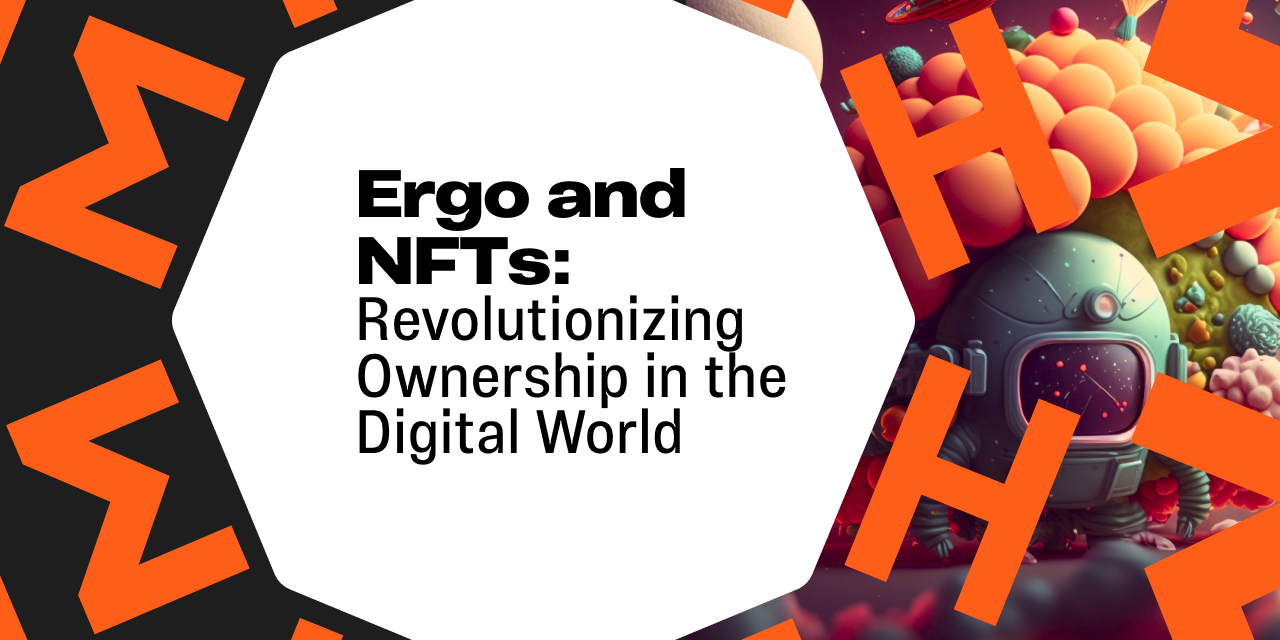Ergo and NFTs: Revolutionizing Ownership in the Digital World
September 5, 2023

Until recently, ownership of an asset referred to physically owning something or at least having something written on a piece of paper that was representative of said ownership. With the seemingly endless digitization of nearly everything these days, the concept of ownership has begun to change in a revolutionary way.
What are NFTs?
NFT stands for non fungible token. A non fungible token is “a unique digital identifier that is recorded on a blockchain, and is used to certify ownership and authenticity. It cannot be copied, substituted, or subdivided. The ownership of an NFT is recorded in the blockchain and can be transferred by the owner, allowing NFTs to be sold and traded.” Depending on the blockchain, it is given a sort of unique token identification number. This is important because if someone decides to attempt to sell an NFT that looks identical, the unique token identification number will confirm which one is real and which one is fake.
Why are NFTs Revolutionizing Ownership Within the Digital World?
Within NFTs, there are many layers of never before seen technology that are not only changing the way people own assets, but also changing the way they are bought, sold, and transferred. As was alluded to earlier, one of the most important technological aspects of NFTs are token IDs. This aids in preventing fraudulent acts when buying, selling or transferring an asset from one person to another. For example, a common scam is the selling of fake concert or sports tickets. Bad actors will often stand outside of a stadium and offer to sell discounted tickets to a show or event. After purchasing a ticket and reaching the ticket gate to enter the event, people find out they were sold a fake ticket that looked exactly like the real one. With NFT technology, this is preventable because tickets that are sold with a unique identification code (mint address on Ergo) will immediately distinguish a real ticket from a fake.
There is also the concept of royalties within NFTs. Most NFT technology supports royalty payments when assets are resold, thereby offering an additional revenue source for an NFT creator. Smart contracts embedded in NFTs enable the process of distributing royalties when an asset is resold, ensuring that artists profit from the rising value of their creations.
Speculation on NFT Mass Adoption and Future Utility
What potential use cases could NFTs have on a global scale? One of the biggest areas of conversation is the digitization of real estate. NFTs can potentially provide the real estate industry with significant benefits, such as the simplification of transactions, facilitating fractional ownership, and offering easier ways to buy and sell properties globally. The fractional ownership of real estate through NFTs is already being executed by an NFT project on Cardano called Platypus Cyberpunks.
The digitization of real estate involving NFTs is extremely intriguing but does have potential drawbacks due to potential smart contract bugs or computer hacks. There may also be regulatory pushback and legal issues due to the lack of clarity on security laws in certain jurisdictions around the world. Nonetheless, NFTs offer a unique way of handling real estate ownership in the future if these issues can be worked out.
Another use case of NFTs is the tokenization and traceability of commodities, such as tea or gold. This is currently being explored by a project on Ergo called zenGate Global. The COO of zenGate, Sam Lambert, states that “The tokenization of real-life assets is the next evolution for NFTs. Through this, we will see the next wave of customers on boarded from outside the blockchain industry.”
The zenGate team states that “NFTs can [also] be used in the supply chain of commodities to represent physical assets such as metals, minerals, and agricultural products. Each NFT represents a specific asset, and its ownership can be transferred on the blockchain. This means that the authenticity and ownership of the asset can be verified at every stage of the supply chain, from production to consumption. Lastly, other metadata can be collected (e.g certifications, credentials) that can be linked to the NFT to ensure that the asset was produced ethically and sustainably.”
The zenGate team explain in their medium article that NFTs can aid in automating asset ownership transfers in the supply chain, thereby cutting out intermediaries, increasing efficiency, and reducing costs. They also enable real-time tracking of commodities, reduce delays and help stakeholders respond swiftly to changing demand. NFTs have the potential to also support regulatory compliance by providing a transparent record of a commodity's journey to ensure it meets safety, quality, and environmental standards. Additionally, they establish trust by certifying the commodity's quality, reducing disputes, and enhancing the reliability of the commodities supply chain - which ultimately benefits all stakeholders.
Conclusion
While many still associate NFTs with JPEGs of monkeys selling for thousands of dollars, it is evident that NFTs have the potential to represent a much deeper sense of utility in the world. NFTs relating to collectibles, art, real estate, commodity markets and so much more are actively revolutionizing the way authenticity and ownership are being handled. Additionally, NFTs are also changing the way assets are bought, sold and transferred. In a world that is becoming increasingly digital, NFTs are sure to play a crucial role in redefining what it means to own something.
Share post